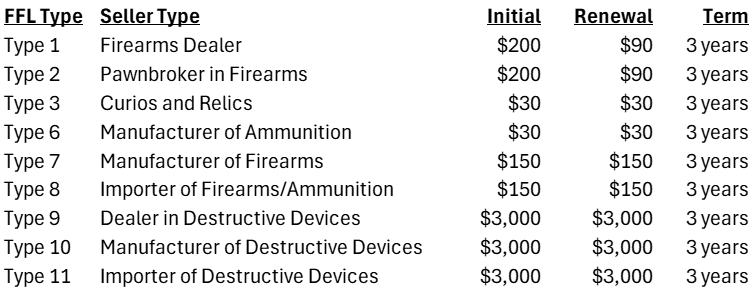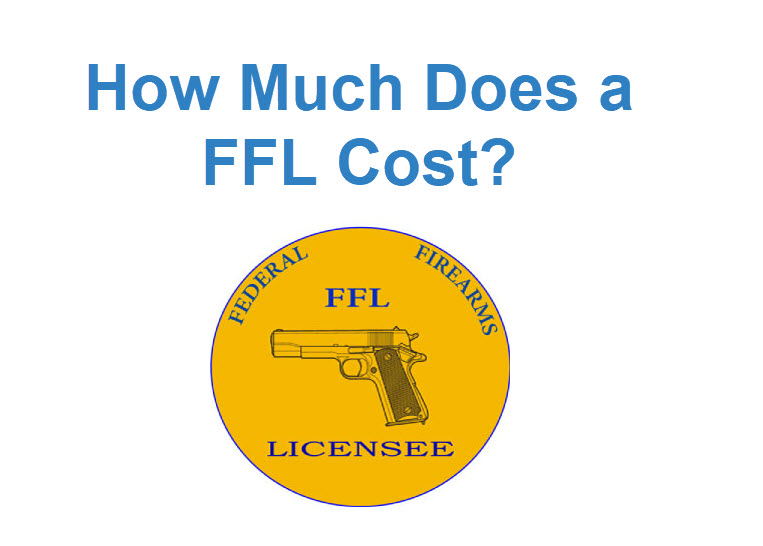How much does a FFL cost? That is a common question when opening a gun store. If you are opening a gun store, a Federal Firearm License (FFL) is required in order for you to be legally be involved in the sale, manufacture, or import of firearms. The cost of an FFL depends on a variety of factors as discussed below. The requirements of FFLs help establish standards in the firearms industry so that firearm transactions are conducted securely and in compliance with law and regulations.
How Are FFL Fee Calculated?
So how much does a FFL cost? The costs associated with acquiring a FFL vary, depending on the license type and the specific business activities it covers.
The ATF categorizes FFLs into several types. Different classes or types of FFLs regulate different parts of the firearms supply chain – from manufacturing to importing to selling. It also covers different type of sellers (dealers, pawnshops and relics). The initial and renewal FFL fee is based on the seller type, with the fee being paid to the ATF’s Federal Firearms Licensing Center. As summarized in the table below, FFL fees range from $30 to $3,000 for three years, with a renewal fee every three years thereafter.

Licensed FFL dealers, manufacturers, and importers pay different fees. The cost for a standard retailer of firearms is very reasonable, given that this allows the licensee to legally deal in firearms.
The FFL Application Process
The process of applying for a FFL is relatively straightforward. Applicants are required to provide details about themselves, their business premises, and the reasons that they are applying for a federal firearms license. Applicants need to pass detailed background check, which includes filing their fingerprints and certifying that the applicant’s firearm business does not violate any local laws. The most common local law impacting FFLs are local zoning regulations. The applicant must also pass an in-person interview with an Industry Operations Investigator (IOI) which includes a review the applicant’s completed application.
Extra Fees and Regulations Based in Types of Items Sold
If you are involved in the manufacture, sale, and distribution of defense-related articles and services listed on the U.S. Munitions List (USML), such as weaponry, aircraft and sensitive military data, you will need to comply with the International Traffic in Arms Regulations (ITAR). ITAR compliance governs how ‘defense articles,’ ‘defense services,’ and related ‘technical data’ can be exported from the U.S.
If you sell or deal in National Firearms Act (NFA) items, including specialized firearms such as short barreled rifles (SBRs), machine guns, suppressors, and other destructive devices, you are required to obtain an additional Special Occupational Taxpayer (SOT) status.
FFLs selling NFA items must pay an annual SOT fee, which varies depending on the license type you have, the business you’d like to conduct, and the size of your business. The cost of the SOT fee is $500 per year for most FFLs. But if your firearms business is large, the SOT will increase – with a higher fee of $1000 per year above a certain thresehold. The SOT registration cost is in addition to the cost of the FFL registration fee.
In addition, each transfer of a NFA item is subject to a $200 transfer tax. This transfer tax applies to each NFA item, adding to the overall cost of transactions involving these specialized firearms. For many FFL dealers, the SOT fee can be a significant addition to the initial and ongoing costs of maintaining an FFL – not to mention the cost of the NFA item for your customer.
Each NFA transaction must be documented with an ATF Form 4, which includes a comprehensive background check that can take several months to complete. Dealers also must manage logbooks of their NFA inventory, ensuring all items are accounted for and properly documented.
In addition, the storage and security requirements for NFA firearms are different than those for non-NFA firearms. FFLs dealing with NFA firearms need to have more costly specialized secure storage of firearms to prevent theft or unauthorized access.
State Regulatory Requirements for FFLs
State-specific laws may also impact the overall cost to operate a firearms business. Each state has the authority to impose additional rules, fees, and licensing requirements on firearms businesses operating in their state. In some states, additional permits may be required in addition to the FFL. For example, some states require a separate application and license fee for the sale of handguns. Many states also have minimum requirements for the amount or type of insurance. In some cases, the state requirements are more comprehensive (i.e. expensive) than federal insurance requirements for FFLs.
Firearm Transfer Fees
When a firearm is sold to a buyer in another state, many states require additional paperwork or transfer fees. These fees are relatively small and are based on a per-transaction rate. Most FFLs pass these fees onto the buyer of a firearm.
Conclusion – How Much Does an FFL Cost?
In addition to the cost of a FFL fee, applying for a FFL can be a time-consuming process and require you to submit sensitive personal information to the government. However, the cost of a FFL is relatively reasonable given that it authorizes a holder to be able to legally deal in firearms. In addition, the FFL licensing process helps establish standards in the firearms industry to ensure that firearm transactions are conducted securely and in compliance with firearm laws and regulations. If you would like to better understand the types of FFLs and the specific activities they allow, please see that guidelines posted by the Bureau of Alcohol, Tobacco, Firearms, and Explosives (ATF).
